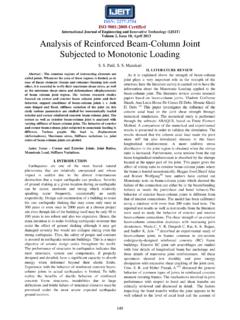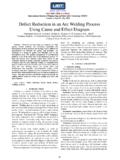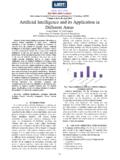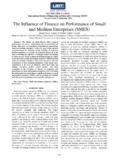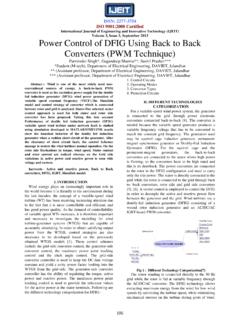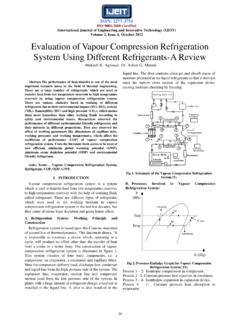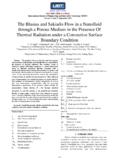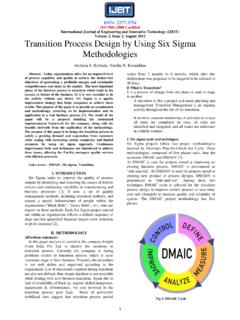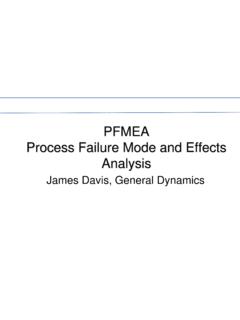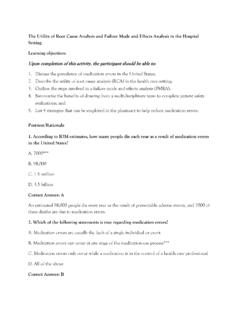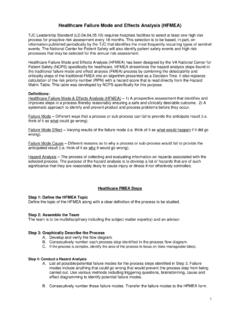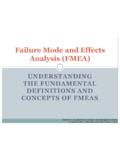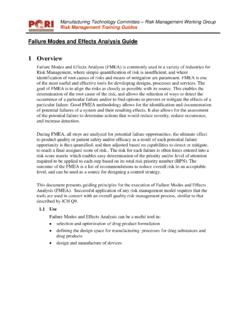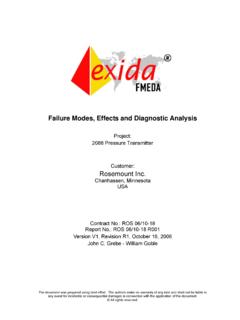Transcription of A Review: Implementation of Failure Mode and …
1 ISSN: 2277-3754. ISO 9001:2008 Certified International Journal of Engineering and Innovative Technology (IJEIT). Volume 2, Issue 8, February 2013. A review : Implementation of Failure Mode and Effect Analysis Swapnil B. Ambekar, Ajinkya Edlabadkar, Vivek Shrouty developed in three main phases, in which appropriate actions Abstract- A Failure modes and effects analysis (FMEA) is a need to be defined. But, before starting with an FMEA, it is procedure in product development and operations management important to complete some pre-work to confirm that for analysis of potential Failure modes within a system for robustness and past history are included in the analysis. classification by the severity and likelihood of the failures. A. A. What is an FMEA? successful FMEA activity helps a team to identify potential Failure modes based on past experience with similar products or A systematic process for identifying potential design and processes, enabling the team to design those failures out of the process failures before they occur, with the intent to eliminate system with the minimum of effort and resource expenditure, them or minimize the risk associated with them FMEA.
2 Thereby reducing development time and costs. procedures are based on standards in the reliability engineering industry, both military and commercial.[4]. I. INTRODUCTION B. Types of FMEA. A Failure modes and effects analysis (FMEA) is a There are several types of FMEA s; some are used much methodology in product development and operations more often than others. The types of FMEA s are shown in management for analysis of potential Failure modes within a Figure [2]. system for classification by the severity and likelihood of the failures. A successful FMEA activity helps a team to identify potential Failure modes, based on past experience with similar products or processes. Failure modes are any errors or defects in a process, design, or item, especially those that affect the customer, and can be potential or actual. Effects analysis refers to studying the consequences of those failures. An example of this is the Apollo Space program.
3 It was also used as application for Hazard Analysis Critical Control Point (HACCP) for the Apollo Space Program, and later the food Fig 1. Types of FMEA. industry in general. The primary push came during the 1960s, Basically two types of FMEA s are used in manufacturing while developing the means to put a man on the moon and industries: (i) The Design FMEA and (ii) The Process FMEA. return him safely to earth. In the late 1970s the Ford Motor The Design FMEA is used to analyze products before they are Company introduced FMEA to the automotive industry for released to production and it focuses on potential Failure safety and regulatory consideration after the Pinto affair. modes of products, caused by design deficiencies. Design They applied the same approach to processes (PFMEA) to FMEA s are normally done at three levels system, consider potential process induced failures prior to launching sub-system, and component levels.
4 [2] The Process FMEA is production. It is integrated into the Automotive Industry normally used to analyze manufacturing and assembly Action Group's (AIAG), Advanced Product Quality Planning processes at the system, sub-system or component levels. This (APQP) process to provide risk mitigation in both product type of FMEA focuses on potential Failure modes of the and process development phases. Each potential cause must process that are caused by manufacturing or assembly process be considered for its effect on the product or process and deficiencies. A robustness analysis can be obtained from based on the risk, actions are determined and risks revisited interface matrices, boundary diagrams and parameter after actions are complete. Toyota has taken this one step diagrams. A lot of failures are due to noise factors and shared further with its Design review Based on Failure Mode interfaces with other parts and/or systems, because engineers (DRBFM) approach.
5 The method is now supported by the tend to focus on what they control directly. To start, it is American Society for Quality which provides detailed guides necessary to describe the system and its function. A good on applying the method. FMEA can provide an analytical understanding of FMEA simplifies further analysis. This way approach, when dealing with potential Failure modes and their an engineer can see which uses of the system are desirable and associated causes. When considering possible failures in a which are not. It is important to consider both intentional and design like safety, cost, performance, quality and reliability unintentional uses. Unintentional uses are a form of hostile an engineer can get a lot of information about how to alter environment. It is useful to create a coding system to identify the development/manufacturing process in order to avoid the different system elements. Before starting the actual these failures.
6 The process for conducting an FMEA. FMEA, a worksheet needs to be created, which contains the 37. ISSN: 2277-3754. ISO 9001:2008 Certified International Journal of Engineering and Innovative Technology (IJEIT). Volume 2, Issue 8, February 2013. important information about the system, such as the revision Identifying Failure detection methods/corrective actions date or the names of the components. On this worksheet all the items or functions of the subject should be listed in a logical Formulating practical FMEA tests, dockside manner. [2]. Conclusions C. Objectives of FMEA. To identify potential design and process failures before FMEA report structure they occur and to minimize the risk of Failure by either proposing design changes or, if these cannot be E. FMEA Procedure formulated, proposing operational procedures. Essentially Following steps are used to implement the FMEA: the FMEA is to.[4] 1. Severity (S). Determine all Failure modes, based on the functional Identify the equipment or subsystem, mode of operation requirements and their effects.
7 Examples of Failure modes are: and the equipment.[4] electrical short-circuiting, corrosion or deformation. A Failure mode in one component can lead to a Failure mode in another Identify potential Failure modes and their causes.[4]. component; therefore each Failure mode should be listed in Evaluate the effects on the system of each Failure mode.[4] technical terms and for function. Thereafter the ultimate effect of each Failure mode needs to be considered. A Failure effect is Identify measures for eliminating or reducing the risks defined as the result of a Failure mode on the function of the associated with each Failure mode.[4] system as perceived by the user. In this way it is convenient to write these effects down in terms of what the user might see or Identify trials and testing necessary to prove the experience. Examples of Failure effects are: degraded conclusions. [4] performance, noise or even injury to a user.
8 Each effect is given a severity number (S) from 1 (no danger) to 10 (critical). Provide information to the operators and maintainers so These numbers help an engineer to prioritize the Failure that they understand the capabilities and limitations of the modes and their effects. If the severity of an effect has a system to achieve best performance.[4] number 9 or 10, actions are considered to change the design by eliminating the Failure mode, if possible, or protecting the D. How is the FMEA Process Progressed? user from the effect. A severity rating of 9 or 10 is generally Selecting the team reserved for those effects which would cause injury to a user or otherwise result in litigation. Nominating the required specialists 2. Occurrence (O). In this step it is necessary to look at the cause of a Failure Defining the standard mode and the number of times it occurs [5]. This can be done Defining the reporting procedures by looking at similar products or processes and the Failure modes that have been documented for them in the past [5].
9 A. FMEA Team Client Focal Point Designers Failure cause is looked upon as a design weakness. All the Client Focal Point FMEA Team. potential causes for a Failure mode should be identified and documented. Again this should be in technical terms.[5]. Defining the boundaries of the system to be analysed 3. Detection (D). When appropriate actions are determined, it is necessary to The benefit of block diagrams. These break the DP. test their efficiency. In addition, design verification is needed. system down from a high system level to lower system The proper inspection methods need to be chosen. First, an levels to give a graphic representation of how each engineer should look at the current controls of the system, that system level interacts with another. prevent Failure modes from occurring or which detect the Organising system design information Failure before it reaches the customer. Thereafter one should identify testing, analysis, monitoring and other techniques Drawing log that can be or have been used on similar systems to detect failures.
10 From these controls an engineer can learn how likely Question and Answer ( Q&A ) Punchlists it is for a Failure to be identified or detected. Each combination from the previous two steps receives a detection Worksheets number (D). This ranks the ability of planned tests and inspections to remove defects or detect Failure modes in time. FMEA Report Forms The assigned detection number measures the risk that the Failure will escape detection. A high detection number Traceability of information indicates that the chances are high that the Failure will escape Evaluating the effects on the system of each Failure detection, or in other words, that the chances of detection are mode low. 38. ISSN: 2277-3754. ISO 9001:2008 Certified International Journal of Engineering and Innovative Technology (IJEIT). Volume 2, Issue 8, February 2013. After these three basic steps, risk priority number (RPN) is FMEA Form calculated 4. Risk priority number (RPN).
